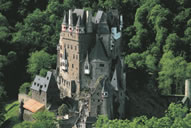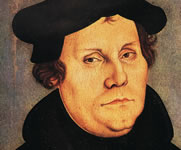Famous People
- Fairytale refuges for the fairytale king
- A paradise born of the Age of Enlightenment
- Fruits borne of strong women
- The “Sun King” of Saxony
- A romantic symbol of German history
- “My heart belongs to my garden”
- Royal life in modern times
- One masterpiece by two geniuses
- Monument to a passion for horticulture
- Count Bernadotte's flower island
- Preserving the cultural heritage
- Retreat for a king and philosopher
- A successful symphony of art and nature
- A Guelph family heirloom
Contact
A romantic symbol of German history
Wartburg Castle remains a repository of almost one thousand years of turbulent German history. It was the setting of the fabled Battle of the Bards that involved, among others, the medieval poets Wolfram von Eschenbach and Walther von der Vogelweide. The tale is immortalised in the music of Richard Wagner's opera “Tannhäuser” and the mural painted by Moritz von Schwindt. Wartburg Castle was also where Elisabeth of Thuringia renounced courtly splendour and was canonised for her charitable work in 1235. The fascinating lords of the castle have included the crusader and minnesinger Heinrich, and Albrecht the “degenerate” who fought wars against his own family. In stark contrast, the castle is also associated with the famous reformer Martin Luther, who translated the New Testament here and is said to have hurled his ink pot at the devil. The great poet Johann Wolfgang von Goethe was also fascinated by Wartburg Castle as a monument of medieval culture.
Wartburg Castle, Eisenach
Show on map »
Anholt moated castle, Isselburg-Anholt

Show on map »
Eltz Castle

Show on map »
Marksburg Castle
Show on map »
Imperial Palace, Goslar
The discovery of veins of silver led the Saxon and Salian emperors to build their largest and most secure castle here on the edge of the Harz mountains. For centuries, it was the preferred seat of government in the north of Germany. The numerous spires of 47 churches and chapels give the town its remarkable silhouette. Together with Goslar's old quarter, the palace is part of the town's UNESCO World Cultural Heritage. Built under Heinrich III between 1040 and 1050, it is the largest, oldest and best-preserved imperial residence in Germany.
Show on map »
Show on map »
Travel Planner
Select an option...
Location
- Imperial Palace, Goslar
- Wartburg Castle, Eisenach
- Anholt moated castle, Isselburg-Anholt
- Marksburg Castle
- Eltz Castle



